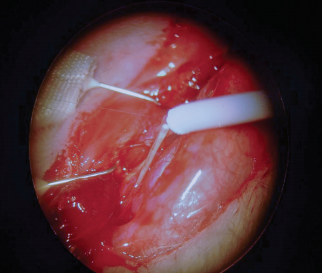Objective: The aim of this study was to compare the outcomes of primary nerve repair using either ethyl-cyanoacrylate or conventional microsuture technique in a rat peripheral nerve injury model.
Methods: In this study, a total of 30 Wistar Albino rats weighing between 220 and 275 g were used. The rats were randomly divided into three groups (10 in each), including one control (group 1) and two experimental groups (group 2, conventional microsuture repair; group 3, cyanoacrylate repair). In each group, the sciatic nerve was identified and transected. No further intervention was performed in group 1. The nerve was repaired using the epineural technique with a 10/0 atraumatic nylon in group 2 and synthetic cyanoacrylate adhesive in group 3. At the fifth postoperative week, needle electromyography (EMG) was performed to measure distal latency, combined muscle action potential (CMAP), and motor nerve conduction velocity (MNCV). Following the EMG recordings, animals were euthanized. Nerve samples were collected to evaluate vacuolar degeneration, fibrosis, and foreign body reaction histopathologically.
Results: In the EMG analysis, mean distal latency was significantly shorter in group 1 (0.85±0.09 ms) than in groups 2 (1.17±0.25 ms) (p=0.0052) and 3 (1.14±0.14 ms) (p=0.0026) while no significant differences existed between groups 2 and 3 (p>0.9999). The mean CMAP was greater in group 1 (10.5±0.35 mV) than in groups 2 (2.86±1.28 mV) (p=0.011) and 3 (2.16±1.34 mV) (p=0.0002), but there was no significant difference between groups 2 and 3 (p>0.9999). The mean MNCV was 53.5±5.95, 39.62±7.31, and 39.84±4.73 mm/sec in groups 1, 2, and 3, respectively. There was a significant difference between groups 1 and 2 (p=0.0052) and between 1 and 3 (p=0.0026), but not between 2 and 3 (p>0.9999). In the histopathological evaluation, the mean vacuolar degeneration score was 0, 2.12, and 1.88 in groups 1, 2, and 3, respectively. No obvious difference was observed between groups 2 and 3 (p=0.743). The mean fibrosis score was 0, 1.62, and 1.77 in groups 1, 2, and 3, respectively. There was no significant difference between groups 2 and 3 (p=0.888). The mean foreign body reaction score was 0, 2.5, and 2.44 in groups 1, 2, and 3, respectively. No difference was present between groups 2 and 3 (p=0.743).
Conclusion: Primary nerve repair using the cyanoacrylate adhesive may provide similar electrophysiological and histopathological results as compared to the conventional microsuture repair.
Cite this article as: Atam C, Orhan Z, Toplu G, Serin M, Karaduman ZO, Öztürk A. Comparison of peripheral nerve repair using ethyl-cyanoacrylate and conventional suture technique in a rat sciatic nerve injury model. Acta Orthop Traumatol Turc 2020; 54(3): 330-6. DOI: 10.5152/j.aott.2020.03.156.



.png)
.png)

